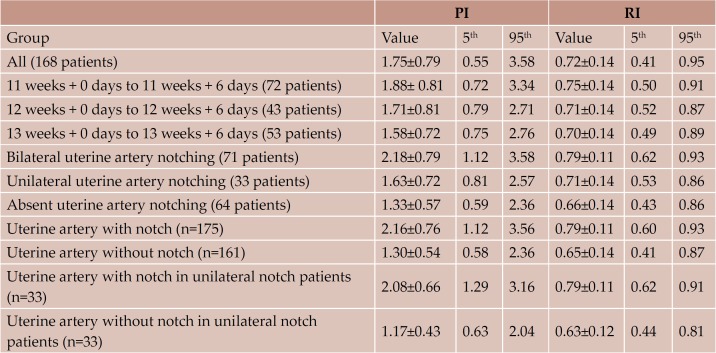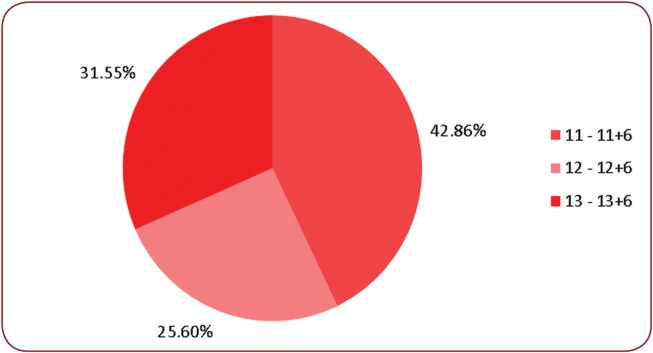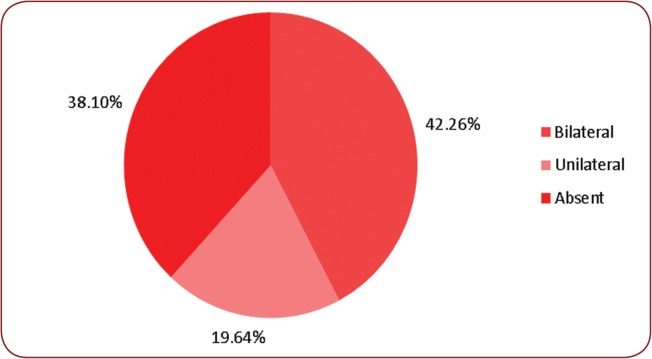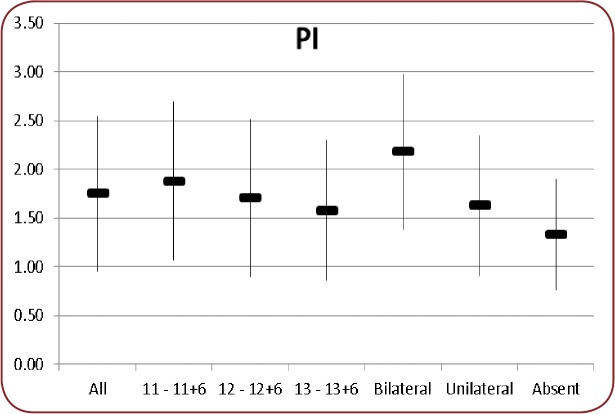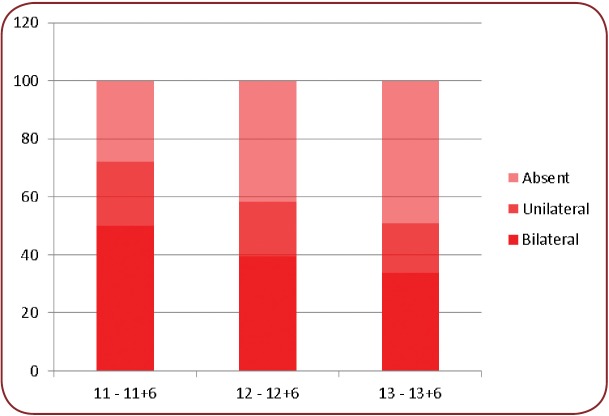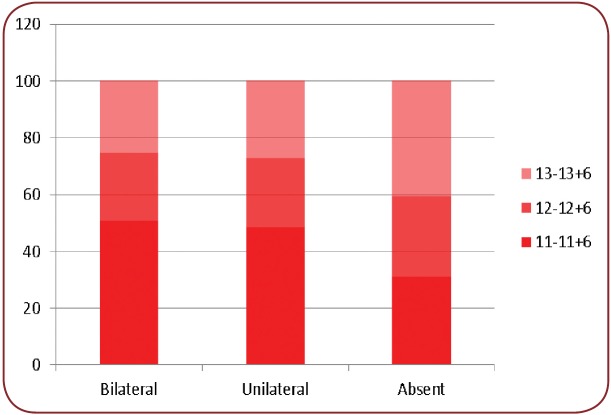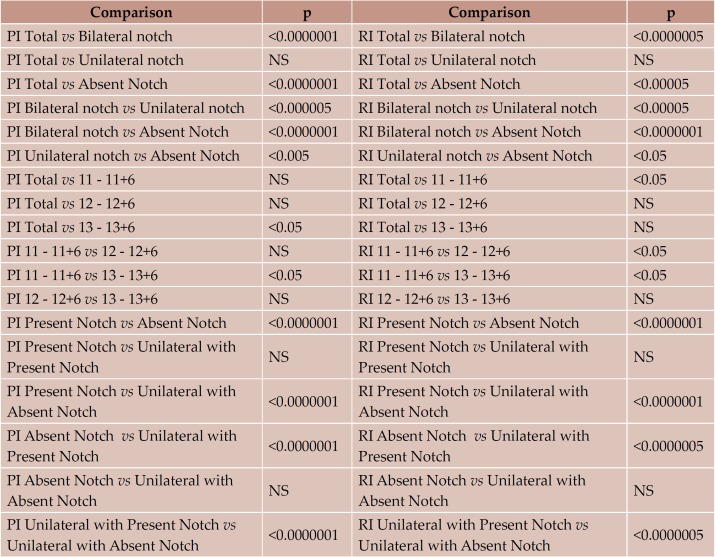Abstract
Objectives:
Uterine artery Doppler flow studies during the 11th and 14th week of pregnancy are important in the prediction of preeclampsia and intrauterine growth restriction in pregnant women as well as in the prevention thereof.
Methods:
Our study on Doppler flow indices of the uterine arteries involved 168 patients examined in our clinic, with pregnancies ranging from 11 weeks + 0 days to 13 weeks + 6 days.
Results:
There were 72 patients from 11 weeks + 0 days to 11 weeks + 6 days (42.86%), 43 from 12 weeks + 0 days to 12 weeks + 6 days (25.60%), and 53 from 13 weeks + 0 days to 13 weeks + 6 days (31.55%). The mean values of the Doppler indices were PI 1.75±0.79, 1.88± 0.81, 1.71±0.81, and 1.58±0.72 and RI 0.72±0.14, 0.75±0.14, 0.71±0.14, and 0.70±0.14 for the entire group and for the three intervals, respectively. There were 71 (42.26%), 33 (19.64%, with 18 cases or 54.55% on the right side), and 64 (38.10%) patients with bilateral, unilateral and absent uterine artery notching, respectively. The mean Doppler indices for the three aforementioned groups were 2.18±0.79, 1.63±0.72, and 1.33±0.57 for the PI, and 0.79±0.11, 0.71±0.14, and 0.66±0.14 for the RI, respectively. The indices for the 175 arteries with and 161 without notching, taken separately, in all patients, as well as for the uterine arteries with and without notching in patients with unilateral notching only were 2.16±0.76, 1.30±0.54, 2.08±0.66, and 1.17±0.43 for the PI, and 0.79±0.11, 0.65±0.14, 0.79±0.11, and 0.63±0.12 for the RI, respectively.
Conclusions:
The mean uterine artery PI and RI decrease from 11 weeks + 0 days-11 weeks + 6 days to 13 weeks + 0 days-13 weeks + 6 days. They also decrease from patients with bilateral uterine artery notching to those without notching. The frequency of uterine artery notching decreases with increasing gestational age. Our results are similar to those in literature.
Keywords:pregnancy, gestational age, uterine artery notching, Doppler indices, pulsatility index, resistivity index, preeclampsia, intrauterine growth restriction
INTRODUCTION
Pre-eclampsia (PE) remains one of the leading causes of maternal and perinatal mortality and morbidity, with an estimated 10-15% of all maternal deaths being due to hypertensive diseases in pregnancy. The prediction of patients at high risk for PE has been a focus of research and, at present, the first trimester is considered to be the preferred gestational period for PE screening (1). The prophylactic use of low-dose aspirin beginning in early pregnancy (prior to 16 weeks) is able to reduce the prevalence of PE by as much as 50% and significantly decrease rates of perinatal death (1). Although no single efficient screening procedure for predicting PE has been adopted in clinical practice, uterine artery Doppler is the most widely studied clinical test available for this particular purpose, becoming a useful method for the indirect assessment of uteroplacental circulation in early pregnancy (11–14 weeks). If combined with examination of maternal history, mean arterial pressure (MAP) and certain biochemical markers (pregnancy-associated plasma protein A or PAPP-A and placenta growth factor or PIGF), uterine artery Doppler may be regarded as an adjunct screening tool for predicting PE and intrauterine growth restriction (IUGR). Abnormal uterine artery Doppler results have been shown to be strongly correlated with several types of adverse maternal and perinatal outcomes (1, 2).
Early identification of pregnant patients at risk of developing PE and IUGR is more likely to facilitate targeted antenatal surveillance and possibly an efficient early intervention. It would also potentially avoid the development of serious complications, through interventions such as administration of low-dose aspirin and, if needed, antihypertensive medication, and early delivery in selected cases (3-5).
In clinical setting, reference ranges for UtA Doppler ultrasound during pregnancy are recommended and used for the appropriate analysis of impedance to blood flow. In this regard, pulsatility index (PI) has been advocated as the best Doppler index in several studies (6). Transvaginal approach was used at 11–14 weeks of gestation, while transabdominal ultrasound was used at 15–41 weeks. After comparing the reproducibility of UtA Doppler PI in the first and second trimesters of pregnancy using both transvaginal and transabdominal ultrasound scan, it has been concluded that PI was evenly significantly higher in both trimesters using transvaginal approach (2, 7-9).
First and second trimester uterine artery Doppler blood flow assessments have high predictive value for clinical outcome (especially in the prediction of preeclampsia and IUGR) (10). In studies which have correlated Doppler velocimetry and clinical outcomes, a rather wide range of specificity and sensitivity values were found for subsequent pregnancy complications (10).
For a correct and clinically significant uterine artery PI measurement, the gestational age must be between 11+0 and 13+6 weeks. Trans abdominal ultrasound should be used to obtain a midsagittal section of the uterus and cervical canal, and the internal cervical os should be identified; afterwards, the transducer should be gently tilted from side to side in each paracervical region, using color flow mapping to identify the uterine arteries as aliasing vessels coursing along the side of the cervix and uterus. Pulsed wave Doppler with the sampling gate set at 2 mm to cover the whole vessel and an angle of insonation <30° should be used to obtain flow velocity waveforms from the ascending branch of the uterine artery at the point closest to the internal os. When three similar consecutive waveforms are obtained, the PI should be measured and the mean PI of the left and right arteries calculated (3, 4).
TABLE 1.
TABLE 1. Mean PI±SD, mean RI±SD, 5th and 95th percentiles
MATERIAL AND METHODS
We assessed the uterine artery Doppler flow indices in 168 pregnant patients within the 11 weeks + 0 days and 13 weeks + 6 days gestational ages in our clinic during the 2014- 2016 period (both in and outpatients) by using a Sonoscape SSI-6000 and a General Electric Logiq e ultrasound devices. The Doppler flow was analyzed with a 2 mm window and an insonation angle of less than 30 degrees, according to existing guidelines.
RESULTS
Among the 168 pregnant women in the group we studied, there were 72 patients from 11 weeks + 0 days to 11 weeks + 6 days (42.86%), 43 from 12 weeks + 0 days to 12 weeks + 6 days (25.60%), and 53 from 13 weeks + 0 days to 13 weeks + 6 days (31.55%) gestational age (Figure 1). The values of the Doppler indices were 1.75±0.79 (range 0.46-4.33), 1.88± 0.81 (range 0.46-4.33), 1.71±0.81 (range 0.55-4.29), and 1.58±0.72 (range 0.49-3.93) for the PI and 0.72±0.14 (range 0.36-1), 0.75±0.14 (range 0.36-1), 0.71±0.14 (range 0.40-0.96), and 0.70±0.14 (range 0.37-0.94) for the RI for the entire group and for the three gestational age intervals, respectively.
Our study revealed that 71 (42.26%), 33 (19.64%), and 64 (38.10%) patients had bilateral, unilateral and absent uterine artery notching, respectively (Figure 2). The Doppler indices for the three aforementioned groups were 2.18±0.79 (range 0.72-4.33), 1.63±0.72 (range 0.55-3.55), and 1.33±0.57 (range 0.46-2.82) for the PI and 0.79±0.11 (range 0.46-1), 0.71±0.14 (range 0.40- 0.96), and 0.66±0.14 (range 0.36-1) for the RI, respectively.
After assessing the uterine arteries in the study group according to the presence or absence of notching, the indices for the arteries with (n=175, including 142 in 71 patients with bilateral notching and 33 in 33 patients with unilateral notching) and without notching (n=161, including 33 in 33 patients with unilateral notching and 128 in 64 patients without notching) in all 168 patients, as well as for the uterine arteries with and without notching in the 33 patients with unilateral notching, were 2.16±0.76 (range 0.72-4.33), 1.30±0.54 (range 0.46-2.82), 2.08±0.66 (range 0.91-3.55), and 1.17±0.43 (range 0.55-2.09) for the PI and 0.79±0.11 (range 0.46-1), 0.65±0.14 (range 0.36-1), 0.79±0.11 (range 0.52-0.96), and 0.63±0.12 (range 0.40-0.86) for the RI, respectively
Table 1 presents the mean, standard deviations and the 5th and 95th percentiles for the pulsatility and resistivity indices, while figures 3 and 4 present the means and the standard deviations thereof.
Table 2 and Figure 5 show the frequency of different types of uterine artery notching among the three gestational age groups (a decrease in the frequency of both can be observed), while Table 3 and Figure 6 present the distribution of types of uterine artery notching among the three gestational age groups (approximately half of the cases with bilateral or unilateral artery notching are in the 11 weeks + 0 days to 11 weeks + 6 days gestational age group).
We used Student’s t-test to compare the PI and RI among different groups (all patients versus different gestational age groups and versus groups according to the presence or absence of notching, as well as different groups between them, and the indices of all uterine arteries with and without notching within the group), the results being shown in table 4 (NS=non significant) (Table 4).
In the group we studied, uterine artery notching was always absent in case of PI below the 5th percentile and RI below the 4th percentile and always present in case of PI above the 90th percentile, while no such percentile could be established for the RI (there were two patients with an RI of 1 and absent notching). A PI below 0.85 (12th percentile) yields a FPR (false positive rate), defined as a present uterine artery notch, of 2.5%; a PI above 2.77 (11th percentile) leads to a FNR (false negative rate), defined as an absent uterine artery notching, of 5.4%. As for the RI, the FPR for a value below 0.53 (11th percentile) was 8%, while the FNR for a value above 0.91 (94th percentile) was 10%.
FIGURE 1.
FIGURE 1. Age group distribution
FIGURE 2.
FIGURE 2. Notch type distribution
FIGURE 3.
FIGURE 3. Mean PI±DS
FIGURE 4.
FIGURE 4. Mean RI±DS
TABLE 2.
TABLE 2. Distribution of frequency of diff erent types of uterine artery notching among the three gestational age groups
FIGURE 5.
FIGURE 5. Distribution of frequency of diff erent types of uterine artery notching among the three gestational age groups
FIGURE 6.
FIGURE 6. Distribution of types of uterine artery notching among the three gestational age groups
TABLE 3.
TABLE 3. Distribution of types of uterine artery notching among the three gestational age groups
TABLE 4.
TABLE 4. Comparison of PI and RI
DISCUSSION
The frequency of bilateral uterine artery notching in our study is 42.26% and the frequency of both bilateral and unilateral uterine artery notching decrease with increasing gestational age.
The results in our study are similar to those in literature:
– mean PI 1.79, 1.68, 1.58, and 1.49 at 11, 12, 13 and 14, with the 95th percentile at 2.70, 2.53, 2.38, and 2.24 weeks, respectively (11);
– PI 1.96±0.6, 1.83±0.53, 1.71±0.47, and 1.58±0.41, with the 95th percentile at 3.13, 2.88, 2.63, and 2.38 at 11, 12, 13, and 14 weeks, respectively (12);
– PI 1.6±0.5, 1.5±0.6, 1.4±0.4, and 1.3±0.4 at 11, 12, 13, and 14 weeks, respectively (1);
– RI 0.7±0.1, 0.7±0.1, 0.6±0.1, and 0.6±0.1 at 11, 12, 13, and 14 weeks, respectively (1);
– PI 2.32 ± 0.79 and RI 0.83 ± 0.07 with notching, 1.61 ± 0.78 and 0.71 ± 0.16 without notching (13);
– 95th percentile of RI at 11-14 weeks at 0.85 (14);
– the frequency of bilateral notching 48.6%, 47.9%, 30.6%, and 28.4% at 11, 12, 13, and 14 weeks, respectively (12).
CONCLUSION
The mean uterine artery PI and RI and the frequency of bilateral and unilateral uterine artery notching decrease from 11 weeks + 0 days- 11 weeks + 6 days to 13 weeks + 0 days-13 weeks + 6 days. They also decrease from pregnant patients with bilateral uterine artery notching to those without notching.
Our aim is to screen, as much as possible, all pregnant patients between 11 and 14 weeks of pregnancy who are referring to our clinic of pregnancy by uterine artery Doppler ultrasound, in order to discover bilateral notching as soon as possible for specific prophylactic treatment, according to existing guidelines and recommendations, to be started.
Conflict of interests: none declared.
Financial support: none declared.
Contributor Information
Voicu DASCAU, Department of Obstetrics and Gynecalogy, „Vasile Goldiº” Western University, Arad, Romania.
Gheorghe FURAU, Department of Obstetrics and Gynecalogy, „Vasile Goldiº” Western University, Arad, Romania.
Cristian FURAU, Department of Obstetrics and Gynecalogy, „Vasile Goldiº” Western University, Arad, Romania.
Cristina ONEL, Department of Obstetrics and Gynecalogy, „Vasile Goldiº” Western University, Arad, Romania.
Casiana STANESCU, Department of Anatomy, „Vasile Goldiº” Western University, Arad, Romania.
Liliana TATARU, Department of Obstetrics and Gynecalogy, „Vasile Goldiº” Western University, Arad, Romania.
Cristina GHIB-PARA, Department of Haematology, „Vasile Goldiº” Western University, Arad, Romania.
Cristina POPESCU, Department of Life Sciences, „Vasile Goldiº” Western University, Arad, Romania.
Luminita PILAT, Department of Phsyology, „Vasile Goldiº” Western University, Arad, Romania.
Maria PUSCHITA, Department of Internal Medicine, „Vasile Goldiº” Western University, Arad, Romania.
REFERENCES
- Alves JA, Silva BY, de Sousa PC, Maia SB, Costa Fida S. - Reference range of uterine artery Doppler parameters between the 11th and 14th pregnancy weeks in a population sample from Northeast Brazil. Rev Bras Ginecol Obstet. 2013;35:357–362. doi: 10.1590/s0100-72032013000800004. [DOI] [PubMed] [Google Scholar]
- Peixoto AB, Da Cunha Caldas TM, Tonni G, De Almeida Morelli P, Santos LD, Martins WP, Araujo Júnior E. - Reference range for uterine artery Doppler pulsatility index using transvaginal ultrasound at 20-24 weeks of gestation in a low-risk Brazilian population. J Turk Ger Gynecol Assoc. 2016;17:16–20. doi: 10.5152/jtgga.2016.16192. [DOI] [PMC free article] [PubMed] [Google Scholar]
- Poon LC, Syngelaki A, Akolekar R, Lai J, Nicolaides KH. - Combined screening for preeclampsia and small for gestational age at 11–13 weeks. Fetal Diagn Ther. 2013;33:16–27. doi: 10.1159/000341712. [DOI] [PubMed] [Google Scholar]
- Khalil A, NicolaideS KH. - How to record uterine artery Doppler in the fi rst trimester. Ultrasound Obstet Gynecol. 2013;42:478–479. doi: 10.1002/uog.12366. [DOI] [PubMed] [Google Scholar]
- Roberge S, Nicolaides KH, Demers S, Villa P, Bujold E. - Prevention of perinatal death and adverse perinatal outcome using lowdose aspirin: a meta-analysis. Ultrasound Obstet Gynecol. 2013;41:491–499. doi: 10.1002/uog.12421. [DOI] [PubMed] [Google Scholar]
- Ferreira AE, Mauad Filho F, Abreu PS, Mauad FM, Araujo JuniorE, Martins WP. - The reproducibility of fi rst and second trimester uterine artery pulsatility index by transvaginal and transabdominal ultrasound. Ultrasound Obstet Gynecol. 2015;46:546–552. doi: 10.1002/uog.14762. [DOI] [PubMed] [Google Scholar]
- Scandiuzzi RM, de Campos Prado CA, Araujo Júnior E, et al. - Maternal uterine artery Doppler in the fi rst and second trimesters as screening method for hypertensive disorders and adverse perinatal outcomes in low-risk pregnancies. Obstet Gynecol Sci. 2016;59:347–356. doi: 10.5468/ogs.2016.59.5.347. [DOI] [PMC free article] [PubMed] [Google Scholar]
- Ghulmiyyah L, Sibai B. - Maternal mortality from pre¬eclampsia/eclampsia. Semin Perinatol. 2012;36:56–59. doi: 10.1053/j.semperi.2011.09.011. [DOI] [PubMed] [Google Scholar]
- Velauthar L, Plana MN, Kalidindi M, et al. - First-trimester uterine artery Doppler and adverse pregnancy outcome: a meta-analysis involving 55,974 women. Ultrasound Obstet Gynecol. 2014;43:500–507. doi: 10.1002/uog.13275. [DOI] [PubMed] [Google Scholar]
- Akbaº M, ªen C, Calay Z. - Correlation between First and Second Trimester Uterine Artery Doppler Velocimetry and Placental Bed Histopathology. Int Sch Res Notices. 2014;13:2014. doi: 10.1155/2014/890534. [DOI] [PMC free article] [PubMed] [Google Scholar]
- Gómez O, Figueras F, Fernández S, et al. - Reference ranges for uterine artery mean pulsatility index at 11–41 weeks of gestation. Ultrasound Obst Gyn. 2008;32:128–132. doi: 10.1002/uog.5315. [DOI] [PubMed] [Google Scholar]
- Gomez O, Figueras F, Martinez JM, et al. - Sequential changes in uterine artery blood flow pattern between the first and second trimesters of gestation in relation to pregnancy outcome. Ultrasound Obstet Gynecol. 2006;28:802–808. doi: 10.1002/uog.2814. [DOI] [PubMed] [Google Scholar]
- Gadelha da Costa AG, Spara Patricia, de Oliveira Costa T, Neto WRT. - Uterine arteries resistance and pulsatility indices at the fi rst and second trimesters of normal pregnancies. Radiol Bras. 2010;43:161–165. [Google Scholar]
- Melchiorre K, Leslie K, Prefumo F, Bhide A, Thilaganathan B. - First-trimester uterine artery Doppler indices in the prediction of small-for-gestational age pregnancy and intrauterine growth restriction. Ultrasound Obstet Gynecol. 2009;33:524–529. doi: 10.1002/uog.6368. [DOI] [PubMed] [Google Scholar]



